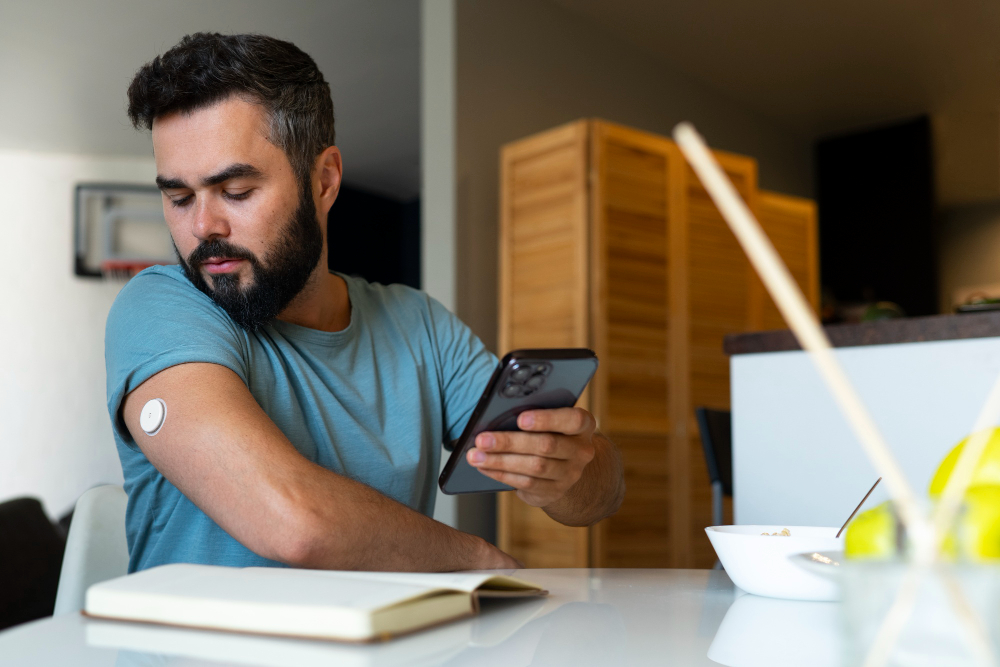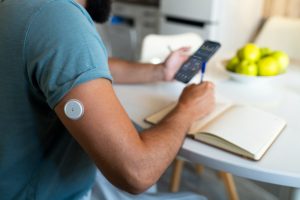
From Readings to Results: Using CGM to Guide Your Diet
This guide will help you use your CGM readings to make smarter food and sugar choices, helping you understand how different foods affect your body so you can take control of your blood sugars with confidence.
? What is a CGM?
A CGM or Continuous Glucose Monitor is a small device featuring a sensor placed under your skin that measures your blood sugars by using data from your interstitial fluid. This is the fluid in between the cells of your body. This data is sent to your phone or a reader device, showing how your glucose levels change throughout the day and night.
This gives you a clearer picture of how your body responds to food, activity, stress, and medications. This non-stop tracking helps:
- Identify which foods cause glucose spikes
- Adjust meal timing and food choices
- Improve outcomes like A1c, low blood sugars, and weight loss
? Understand Your CGM Numbers
Most CGMs will show you the following metrics:
- Current glucose (mg/dL): Your live number
- Trend arrows: Indicate whether your glucose is rising, steady, or falling
- Time in range: The percent of time your glucose stays between 70 – 180 mg/dL. Aim for 70% or more.
- Average glucose: Reflects overall glucose control
- Graph of past readings: Shows spikes, drops, and trends over hours or days
- Glucose variability: Measures how much your glucose fluctuates. Less variability = better control
This data can help you connect meals and habits with glucose patterns, helping you make adjustments.
? How Foods Impact Your Blood Sugar
What causes a spike?
- Simple carbs like white bread or soda quickly elevate glucose often followed by sharp dips.
- Meals heavy in sugar or starch, with little fiber or protein tend to spike more.
What helps keep it steady?
- Complex carbs like whole grains, legumes, and veggies digest more slowly, leading to gradual glucose rises and less dramatic swings.
- Adding protein, healthy fats, and fiber with carbs can significantly reduce post-meal spikes.
? CGM Strategies for Smarter Eating
Use your CGM to test and adjust in real time. Here are some proven tricks:
- Pair your carbs: Add fat, protein, or fiber to reduce blood sugar spikes.
- Time your meals: Eat when your glucose is steady, not when it’s already rising quickly
- Move after meals: A 10-15 minute walk can help flatten post-meal spikes
- Check labels: Watch out for hidden sugars and refined carbs in packaged foods
- Portion control: Even healthy carbs can spike your blood sugars; use your CGM data to find your balance.
These simple tweaks help you enjoy a wider variety of foods without compromising glucose stability.
?After You Eat: Watch for Spikes
Check your CGM readings 1 – 2 hours post-meal.
- If you’re under 180 mg/dL, you’re in great shape.
- If you see a spike above 180 mg/dL, your meal may have been high in simple carbs or lacked balance.
No need to panic! This is valuable feedback. Try using the strategies below:
- Adding more protein or fiber
- Reducing portion sizes
- Swapping in more complex carbs next time
Think of each meal as an experiment, not a test.
? Learn from Patterns
Track what you ate, when you ate it, and what was going on in your day (like stress, sleep or exercise).
Ask yourself:
- What foods cause steady vs. spiking responses?
- Do certain times of day lead to higher readings?
- How does movement change your numbers?
Pro Tip: Take screenshots of your CGM graphs or jot notes in a food/mood tracker. This way, you can start spotting patterns fast.
SummaryRemember it’s about patterns, not perfection. One high reading doesn’t mean failure, it means you have new information to build on. Your CGM is like a GPS, see where you are and adjust your route if needed.
Over time, these insights help you develop a more stable, sustainable relationship with food and blood sugar. Smarter choices start with clearer feedback and your CGM gives you exactly that.







